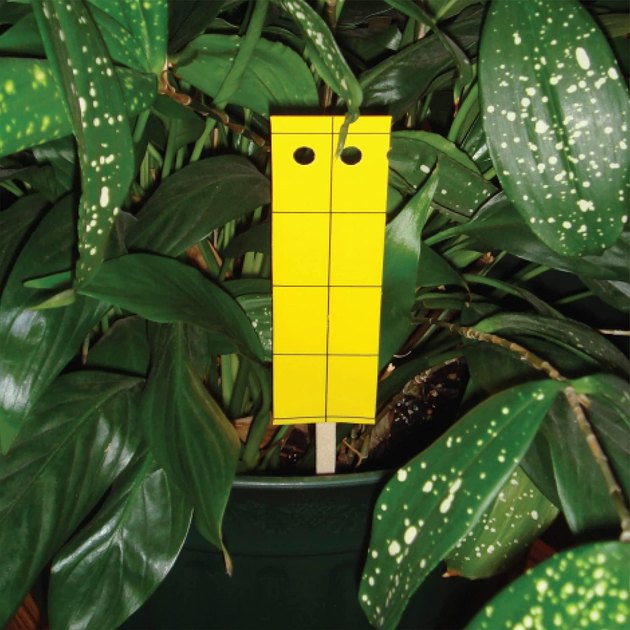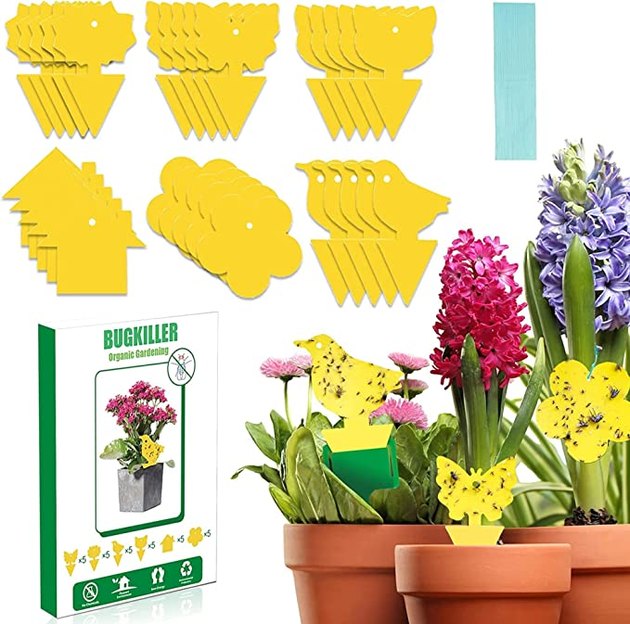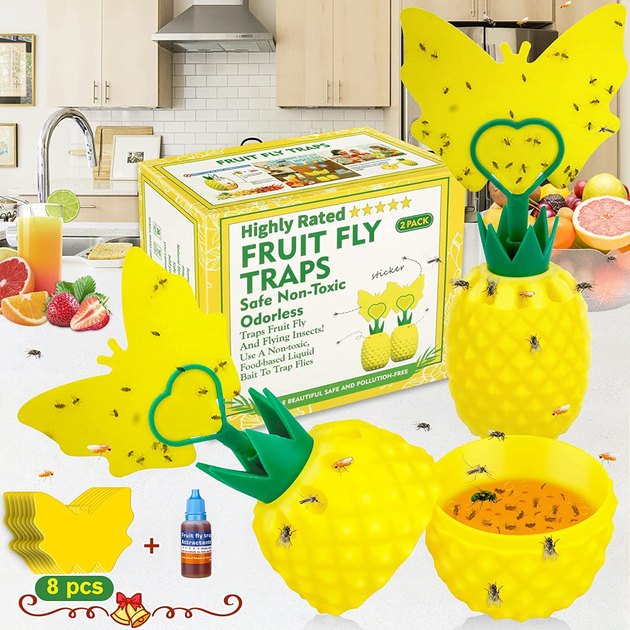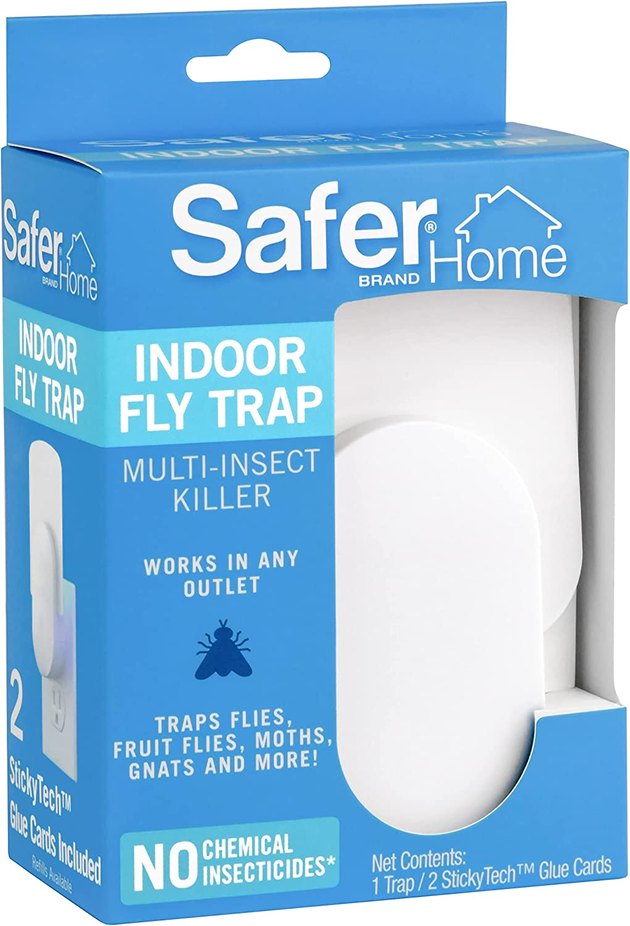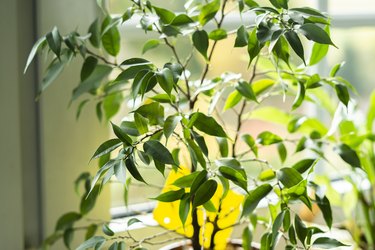
You've spotted a new houseplant, and it's the perfect addition to pump up the greenery in your indoor space. However, once you bring the plant home, you're suddenly inundated with a flying bug infestation. Although pests like aphids, whiteflies, mealybugs and spider mites commonly infest indoor plants, fungus gnats are by far the most annoying. Although the other pests might not be so noticeable, a fungus gnat infestation will fly directly in your face.
Fungus gnat problems can be mistaken for other flying insects like fruit flies or dreaded mosquitoes, but these tiny black kings of annoyance don't bite. Unlike fruit flies, fungus gnats also aren't attracted to overripe fruit. In fact, all that tender care you're giving your indoor plants might be creating the gnat problem and making it worse. Fortunately, there are various nontoxic pest-control options for indoor use that will make your gnat problem a thing of the past.
Video of the Day
Video of the Day
Below, we've outlined some considerations and features regarding the various types of traps and their functions. We also discuss conditions that attract these pests and the steps for prevention. We then dive into our recommendations for the best traps on the market that kill gnats quickly.
What to Consider When Purchasing Gnat Traps
Fungus Gnat Causes: You might wonder what causes a fungus gnat problem and how they got inside your home. The tiny gnats feel right at home inside your home's sink drain, in moist sewer areas and in wet plant soil. You can introduce the tiny black pests through unsterilized potting soils or even through that vase of cut flowers, especially if those flowers sit in a vase filled with stinky unchanged water.
Many types of potting soils contain ingredients that assist in retaining moisture. If you water too frequently, keeping the soil wet, you make your home an inviting place for the gnats. The gnats lay eggs in moist soil, and with their larvae only 1/100 of an inch long, you most likely won't even notice their presence until they begin flying around in your face. The gnats are attracted to the carbon monoxide we exhale. The larvae take around 10 days to develop into flying adults, and the gnats can continue to reproduce indoors year-round.
Diagnosing a Gnat Problem: There's no denying there's a gnat problem once the flying insects start buzzing around, but there are other more subtle signs of an infestation. Although fungus gnats are usually more bothersome than deadly to your plants, they can be damaging in severe untreated cases. The larvae eat soil debris and plant roots. If your plant stops growing and leaves yellow and drop, you might have a gnat problem. This is especially true if you overwater and the plant develops root rot. Since fungus gnats thrive in wet conditions, if your indoor plant develops root rot, there's a good possibility the gnats have also invaded the soil and assisted in the plant's demise.
Preventing a Gnat Problem: You can prevent a gnat problem by avoiding overwatering your plants. Allow the soil to dry before applying more water, and don't keep it wet. Use pots that drain to prevent overly moist soil conditions, which also helps prevent root rot. Additionally, check your houseplants for pest problems before bringing them indoors.
Types of Gnat Traps: Most fungus gnat traps are categorized as either physical traps or electrical traps. Physical traps like yellow sticky traps are economical and easy to use. The traps are positioned in an area where the gnats are bothersome, and they stick to the paper and die. Many sticky traps don't contain harmful insecticides so they're safe to use around pets and children. The traps also work well for fruit flies, houseflies as well as other flying indoor pests.
Electrical traps utilize electricity to lure in the gnats and kill them. Many models plug into a receptacle to receive power, while some use solar energy and are rechargeable. Models may attract the gnats with bright lights and kill them by zapping them with an electrical current. Other types may suck the gnats inside and kill them using a fan.
Although commercially available gnat traps are easy to use and most won't break the bank, you can also make DIY gnat traps. Mix several drops of dish soap into a small container of apple cider vinegar and place where the gnats congregate. The pests are attracted to the mixture and will fall in and die. Just keep repeating the process until your fungus gnat problem is a thing of the past.
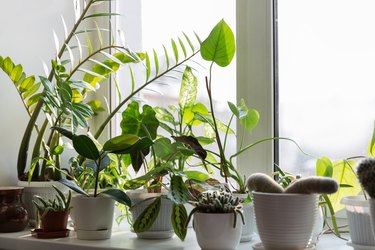
The Best Overall Gnat Trap
Whether you're plagued with fungus gnats, other gnat types, fruit flies, no-see-ums, moths or mosquitoes, this Katchy indoor insect trap makes quick work of killing them. This unit sends out a powerful UV light, attracting the flying pests that are then sucked into the unit by its powerful airflow. The insects get stuck to the enclosed glue trap and die. Once the glue trap becomes filled, you simply remove it and replace it with one of the enclosed refills. The unit has a stylish design and is small enough that it won't add clutter to your countertops. Simply place it near your gnat-infested plants, trash cans or a bowl of fruit, and plug it in to keep your space gnat-free. For the best bug-killing results, it's recommended to run the unit at night and before you know it—your gnat problem is a thing of the past!
The Best Sticky Gnat Traps
These pesticide-free gnat sticky traps from Enzo not only kill all types of problem gnats but also work by ridding your plants of aphids and plant lice. The insects are attracted to the yellow sticky surface and the UV dye incorporated in the glue. Made from paper and a vegetable-based adhesive, the sticky traps are compostable, and you can easily dispose of them without having to touch the portion of the trap filled with dead insects. They are a breeze to use as you simply attach a sticky trap to the enclosed stick and place it in your affected plant. You can also hang the traps from your trailing houseplants. Replace the traps every three months or sooner if they become filled with gnats. Each package contains 12 traps.
The Best Budget Gnat Traps
Whether you want to rid your home of fungus gnats, fruit flies or mosquitoes, these sticky traps will eliminate the problem quickly and efficiently. You won't spend a fortune as the package contains 30 traps that come in a variety of shapes. These nontoxic and odorless sticky traps use a bright yellow color to attract pests. They are waterproof, UV-resistant, resistant to high temperatures, and double-sided so they catch gnats on both sides. The traps are easy to use as you only have to stick them into the infested plant. Once the sticky surface is filled with dead gnats you can replace it with a new one.
The Best Reusable Gnat Trap
This reusable pineapple-shaped gnat and fruit fly catcher and trap attracts pests visually and through smell. You can attract and kill the nuisance insects with the double-sided yellow sticky tape and lure them to their deaths when they enter the bate-filled container. The trap's bright yellow color attracts insects and the funnel design makes it easy for gnats to enter but hard for them to escape. You attach a piece of yellow sticky tape to the top of the pineapple to catch pests and fill the inside with the included bait to trap gnats inside. The sticky tape is odorless and nontoxic. Once you run out of the included bait, you can purchase more or easily make your own. Fill the pineapple's inside with several drops of liquid dish soap and apple cider vinegar or a piece of fruit if you're attracting fruit flies. Once the trap is ready for use, sit it where you need it to do its job.
The Best Inconspicuous Gnat Traps
If you prefer a gnat trap that isn't as noticeable and blends in well with your plant's foliage then these insect traps from Harris are a good choice. The pesticide-free traps kill all types of gnats, aphids, whiteflies and more while being nontoxic and safe for use around kids and pets. Each package contains seven green stakes that hold the sticky traps and blend in well with your indoor plants, along with 30 yellow sticky traps. Each stake holds two sticky traps. Just place a sticky trap in each slot on the stake and then stick the stake into your plant's soil. Once the sticky traps become filled with dead gnats, change them out for new ones.
The Best Gnat Traps for Use Around Kids or Pets
This flying insect trap from Safer Brand couldn't be easier to use as all you do is plug it in and it starts doing its job immediately. Not only will it eliminate a fly problem, but the unit also takes care of gnats, fruit flies, moths and more. Flying pests are naturally attracted to the unit's UV light, and once there, they become stuck to the enclosed sticky glue board. Just place the trap where you notice activity and it offers up to 400 square feet of protection without the use of pesticides. This is a good choice for those with pets and children in the home. The trap is space-saving and discrete. Once the sticky paper is filled with dead insects, simply replace it with a fresh one.

